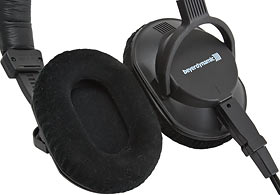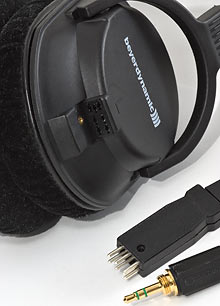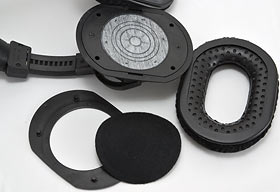
Beyerdynamic DT 250-80 headphones
Review date: 6 December 2004.Last modified 03-Dec-2011.
Full-sized headphones have an image problem.
Not to put too fine a point on it, you tend to look like a bit of a tit when you're wearing them.
Now, I look like a bit of a tit most of the time, so issues like this usually go over my black-plastic-encrusted head. Other people generally need to tell me when something's really ugly. I honestly didn't think at all about what I looked like wearing these until my girlfriend clued me in.
I made a conscious effort, therefore, to think about what Beyerdynamic's DT 250-80 headphones looked like when I first got them out of the box.
So far as I can determine, they look pretty inoffensive by full-sized headphone standards, though certainly not sleek and stylish and ultramodern. And they've got one rather peculiar feature that you may already have noticed. More on that in a moment.
At a glance, you'd think these headphones could have been designed 30 years ago. Only when you look a bit closer do you see that they're mainly made out of tough, lightweight plastic that probably didn't exist back then - plus a steel headband spring, lurking under the removable cushion.
There were plastic headphones back in the 70s, but they were big and clunky, or fragile, or both. These Beyers are about as slim as full-sized circumaural (around-the-ears) headphones can be, but they're still, as far as I can see, as tough as old boots.
Like a lot of full-sized headphones, the DT 250s are billed as a professional high accuracy transparent studio monitor digital reference laboratory analysis 'phones. Unlike most headphones so described, the 250s are actually suitable for such a task.
For a start, they're "closed" headphones; their earpieces seal against your head to block outside noise, which also means not much sound leaks out from them. This is a good thing for studio use, but also for noisy computer rooms, offices, public transport (if you've the courage to wear big black headphones on a bus) and so on.
The 250s also have an old school curly cord cable, which is another plus for many studio and DJ applications. Curly cords let you move away from your decks or mixer or workstation, without leaving you with a long tangly cable all over the place when you come back.
The cable's about 1.3 metres long unstretched (four feet, three inches), and maybe two metres (six feet six inches) at a reasonable level of extension.
If you don't dig the curly cord, though, you could have a bit of a problem, because of the peculiar feature I mentioned above.
In case you haven't spotted it yet, the DT 250 cable plugs into the headphones. That's a standard feature of many quality 'phones these days, and it's a good thing; it makes it easy to swap out a cable that's gotten mangled, and it also reduces the chance of cable damage. The plug'll just pop out of the headphones if the wire pulls taut.
This cable, though, hooks up to the headphones not with a simple standard plug, but with a bizarrely enormous connector.
Yep, that thing's got seven pins on it.
The body of the plug's a good four centimetres (1.6 inches) long, plus more for the rubber strain relief boot on the end. It looks as if the pins are silver plated, as well.
You could power a computer through a plug like this. Using it for the meagre three conductors and tens of milliwatts that a pair of headphones needs seems just a tad over the top to me.
There's some method to Beyer's madness, here. The extra pins on the connector are for a microphone hookup, in addition to the stereo pair. You can't actually buy an add-on microphone for the DT 250s, but there are a few mic-equipped headsets in Beyer's 200-series, and they're just economising on components. There's even a single-sided DT 252, aimed at the DJ market; it uses even fewer of those seven pins.
Cables should be interchangeable between all of the different kinds of DT 2xx 'phones, though I doubt many people are going to find that very useful. If you feel like a bit of headphone hacking, though, the pinout for the connector is in the 2xx-series manual that you can download in PDF format from the DT 250 product page.
The plug on the other end of the DT 250 cable, by the way, is a standard 1/8th inch stereo unit, with a screw thread on it so you can firmly attach the supplied threaded quarter-inch adapter if you like. If you lose the supplied adapter, any normal plug-in adapter will also work.
Oh, and if you don't want the headphone end of the cable to be unpluggable, there's a screw hole through it that lets you fix it to the ear-cup.
Price
HeadRoom in the USA sell the HD 250-80 for $US179 plus shipping. This puts them well above what a lot of people will countenance paying for headphones, but they're only in the middle range of headphones-that-audiophiles-can-tolerate. And, of course, by speaker standards, they're dirt cheap.
(HeadRoom also sell the DT 250-250, for the same price. That's essentially the same thing but with higher impedance; 250 ohms versus, wait for it, 80 ohms for the 250-80. The two models are basically identical, as far as I can see; most people will prefer the 80 ohm version, because it gives you more volume from a given headphone socket output voltage. Many headphone sockets won't be able to drive the 250 ohm 'phones to respectable volume.)
Comfort
You have to make allowances, comfort-wise, when you're evaluating closed headphones.
Open-backed headphones don't have to seal against your skull, so unless they're designed to stay put while you jog, they can float on your head. Some companies manage to make circumaural open headphones that're uncomfortable, but it takes considerable ingenuity.
Closed 'phones need a seal to work properly, so they have to clamp your head somewhat. This usually isn't a problem in the short term, but as the hours wear on most sealed headphones become less and less pleasant to live with.
The DT 250s, however, are quite comfy. I was worried that their earpieces wouldn't quite fit around my ears, because the hole in the middle of the ear cushions is only about 6 by 3.5cm (2.4 by 1.4 inches)in size, but they actually snuggled onto my ears neatly. If you've got unusually large or sticky-out ears then these probably aren't the 'phones for you, but they should fit most people well.
The 250s' head pressure isn't very high by sealed-'phone standards, and they've got fuzzy ear cushions instead of the popular "pleather". I found them quite tolerable after I'd been wearing them for a few hours. Not wonderful, but as good as I think I've any right to expect from sealed 'phones.
Part of the reason for the DT 250s' comfortableness is that the earpieces have a few degrees of fore-and-aft swivel. The swivel joint is very solidly built; the steel inner headband continues down to that point, and a simple screw holds it all together.
That's the design philosophy all through these headphones. No space age super-lightweight clip-together funkitude, just good old fashioned screws, and hidden metal where it's needed.
The DT 250s aren't very heavy, though. Without their cable, they weigh a perfectly acceptable 244 grams (8.6 ounces). That's pretty much on par for full-sized headphones these days.
Listening
The much-abused "studio monitor" term actually does have a meaning. Monitor speakers and headphones are meant to give as uncoloured a view of the audio world as possible.
This isn't the goal of all sound systems, especially not consumer models. A lot of people like a bit of bass emphasis, for instance. Some people like a lot. And there's a whole industry based around the "sweet" distortion of valve amplifiers.
My usual everyday headphones for some years now have been a pair of Sennheiser HD 590s, which are not dead flat "monitor" units. Headphone aficionados don't generally like the 590s much; they complain about their somewhat muted midrange and peaky treble response.
I like them just fine, though, not least because they remain comfortable even when worn for many consecutive hours. They also have a plug-in cable, which has saved itself from yanking damage more times than I care to remember, and they're light, and tough, and look pretty cool too.
I ran through my usual rock, pop, classical and jazz test tracks, and noted that the DT 250s sound significantly less "airy" than the HD 590s, and have noticeably less low bass. They don't have disproportionately low bass, though, or particularly muted treble, or all but the lightest dose of the plastic-cup midrange distortion that's characteristic of many sealed headphones, especially cheap ones.
The 250s also seem to deliver a quite wide stereo soundstage, which tells me that they're accurately reproducing the tricky phase and frequency balance differences that the brain uses to form a stereo image.
And, when I used the 250s in my computer-fan-infested office while writing this review, I was pleased by the fact that the fans didn't invade my awareness nearly as much as they do when I'm wearing the open-backed 590s. Despite the DT 250s' nice and comfy low head pressure, their isolation - blocking of outside noise - is actually pretty good. About the same as various other full-sized sealed 'phones, if you ask me.
Moving on, as usual, to shuffle-mode playing of anything and everything, I noted that the DT 250s entirely successfully allowed me to hear every layer of an intricate samplefest, and delivered as smooth a rendition of roughly recorded work by some obscure Star Trek actor or other as you could expect, but still managed an appropriately ear-piercing rendition of something that's meant to sound as if it's passed through at least four "loudness" filters on the way to the listener.
More jazz went down well, the Interminable Mix of "Welcome To The Pleasuredome" was as non-boring as I've ever heard it, and I could also hear the sibilance of Brian Wilson's mic 40 years ago.
I didn't really want to hear that, to tell you the truth, but that's the deal with proper "monitor" speakers or headphones; they let you hear the music warts and all, and do nothing to hide the defects of the performers, the recording technology, or your lousy MP3 encoder.
(The crowbar also sounded as it should.)
Numbers
The DT 250s are alleged by Beyerdynamic to have a frequency response stretching from 10-30,000Hz.
That's a lot.
Human hearing is usually quoted as extending from 20 to 20,000Hz, but few adults can hear above 14,000Hz, and there's not much program material that stretches that far up either. You won't often hear bass below 20Hz in music, either; actually, even the rumbles and explosions in action movies aren't likely to have much energy way down there.
Getting real 10Hz response out of headphone transducers is not easy, but lots of cheap headphones nonetheless have specs that say they can go down that far, if not further.
Those specs are invariably true only for suitably small values of "true". The 'phones do have response at those extremes, but it's so far down compared with their loudness at other frequencies that there's no way you could ever hear it when listening to normal program material.
Quality headphones like these Beyers, on the other hand, are less misleadingly specified. The response extremes may still be a little exaggerated, but shouldn't be far from the -3dB standard for audio gear - when the response plot drops 3dB below its typical figure, and doesn't come back, that's the end.
When HeadRoom made numbers on the DT 250, they found real response down to, oh, almost 40Hz, allowing a charitable -5dB cutoff point. So, 10Hz bass response? Not true. Not true by rather more than an octave. But 40Hz is perfectly OK; lots of excellent headphones only actually go that far down.
HeadRoom measured the DT 250s' treble response as being all wiggy (a technical term), as is common for headphones in general and sealed headphones in particular. But there's not actually much to complain about there, either; fake-head testing devices like the one HeadRoom uses simulate the oddness imposed upon high frequencies by human heads, so a wiggly line that seems to suggest no very useful response above 10000Hz is not, actually, cause for concern.
(Though you can fake great and august wisdom quite effectively by pointing to such a graph as an explanation for why a crummy pair of headphones sound so bad.)
But, still: 30kHz treble response? No. About the same fib factor as for the treble response figure, I'm afraid.
More relevantly, HeadRoom found that the 250s' distortion graph has the lofty resonance peaks in it that only black magic can prevent in sealed 'phones, but is otherwise well behaved. These headphones' alleged 80 ohm impedance is also, apparently, actually more like 100. Impedance is the only specification I can even attempt to measure with my plebeian collection of test gear here; I got about an 89 ohm DC impedance, which is where the HeadRoom graph is at its 20Hz end, closest to DC.
HeadRoom also found, as I did in my listening tests, that the DT 250s' isolation is about the same as that of various other sealed 'phones. The Sennheiser HD 280s I reviewed a while ago, and the very inexpensive Koss UR20s I reviewed a little later, for instance; compare the graphs and you can see that there's really not much in it at all.
I've thrown the Etymotic ER-4S canalphones I reviewed, um, even earlier, into that comparison graph too, so you can see how really high isolation 'phones perform. Those things literally plug your ears, though; you can't just pop 'em on and off like normal headphones.
Servicing
You can take apart all good headphones. The DT 250 ear pads use the common groove-lock retention method, so you don't have to pop off the plates underneath to remove them. But it's easier to get the pads back on again if you remove the plate and slide it into them first.
Beyer sell headband and ear cushions for the 200-series headphones as spare parts. You can even get PVC ear cushions to replace the cloth ones, if you like.
And you can get replacement cables, but no different kinds of cable; it's curly cord or nothing, I'm afraid.
Overall
I was pleasantly surprised by the DT 250s. Sealed headphones - including some quite expensive ones - often sound quite underwhelming. These, however, don't.
You can get better-sounding 'phones than these for less money, but I can't recall encountering any sealed headphones with this good a package of features, at this price.
Of the sealed headphones I've reviewed, Beyer's own DT 660s aren't hugely more expensive than the DT 250s and sound very good, but most people will find them uncomfortable. The Sennheiser HD 280s are, arguably, better value for money than the DT 250s, but the 250s comfortably outclass the cheaper Sennheisers sonically. If $US70 is not, for you, the difference between having a place to live and being evicted, then drop that much extra for the better-sounding Beyers is not at all a bad idea.
OK, the DT 250s don't look very exciting, and they've got that curly cord with that big-ass plug on the end of it. As drawbacks go, though, those aren't very serious ones.
I like these headphones a lot. Highly recommended.
Review headphones kindly provided by HeadRoom.





